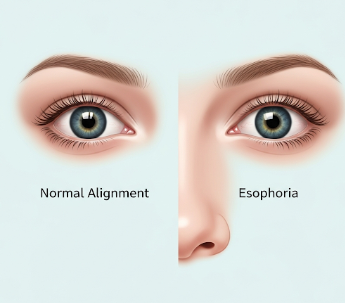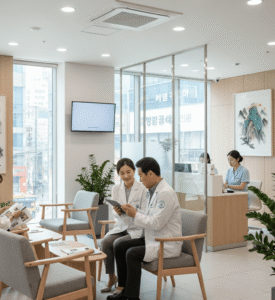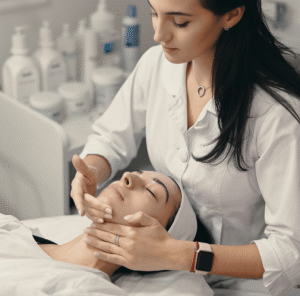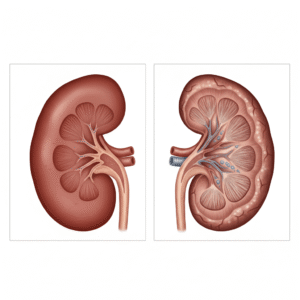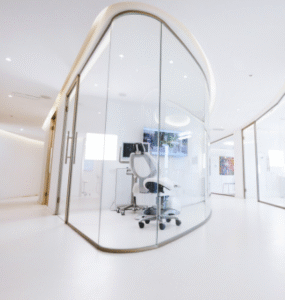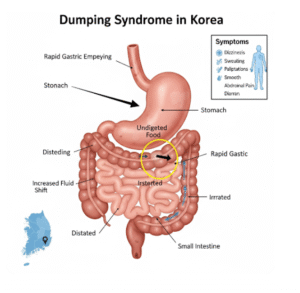Overview
Esophoria is a type of latent eye misalignment (heterophoria) in which the eyes tend to turn inward when the visual system is not actively controlling alignment. Unlike esotropia, which is a constant inward deviation, esophoria is typically hidden under normal binocular vision and becomes apparent only during certain tests or when the eyes are fatigued. In Korea, ophthalmology and optometry clinics provide specialized evaluation, diagnosis, and management of esophoria to reduce symptoms such as eye strain, headaches, or double vision.
Highlights:
➤ Latent inward eye deviation – Eyes drift inward when fusion is disrupted
➤ Often asymptomatic – Symptoms may appear under eye strain or fatigue
➤ Can affect reading, vision comfort, and eye coordination
Key Facts
➤ Prevalence: Esophoria is relatively common and can occur in children and adults.
➤ Age affected: Can develop in childhood or adulthood, sometimes associated with stress or fatigue.
➤ Gender: Affects both males and females.
➤ Impact: May cause eye strain, headaches, blurred vision, or intermittent double vision, particularly during near work or prolonged reading.
What is Esophoria?
Esophoria is a type of heterophoria, meaning it is a latent misalignment of the eyes. The deviation is usually controlled by the brain’s binocular vision system, allowing normal visual alignment under regular conditions. Key characteristics include:
- Inward drift tendency: Eyes naturally want to move toward the nose when fusion is disrupted
- Controlled by fusion reflexes: Normally corrected by the brain to maintain single vision
- Latent condition: Becomes noticeable when one eye is covered or fatigued
Highlights:
➤ Hidden under normal circumstances – Requires specialized testing to detect
➤ Can lead to visual discomfort if binocular control is strained
➤ Not always a sign of serious pathology but can affect quality of vision
What Symptoms Are Related to Esophoria?
➤ Eye strain or fatigue – Especially after prolonged near tasks like reading or computer work
➤ Intermittent double vision (diplopia) – May occur when the eyes are tired
➤ Headaches – Often associated with eye muscle overuse
➤ Blurred vision – Difficulty maintaining focus during close work
➤ Difficulty concentrating on visual tasks – Especially in students or office workers
➤ Occasional closing of one eye – To reduce strain or double vision
Highlights:
➣ Symptoms are often situational and worsen with fatigue or near work
➣ Early detection prevents chronic eye strain and discomfort
What Causes / Possible Causes
➤ Muscle imbalance: Minor variations in extraocular muscle tone can lead to latent inward drift
➤ Refractive errors: Uncorrected myopia, hyperopia, or astigmatism can contribute
➤ Fatigue: Eye muscle fatigue reduces ability to maintain alignment
➤ Stress or illness: Physical or emotional stress can exacerbate latent deviations
➤ Post-surgical or neurological changes: Rarely, eye surgery or neurological conditions can influence ocular alignment
Highlights:
➣ Esophoria usually results from subtle muscular or visual system imbalances
➣ Identifying contributing factors helps optimize treatment and reduce symptoms
When Should I See My Doctor?
➤ Persistent eye strain or headaches – Especially during reading or computer work
➤ Intermittent double vision – Sign of binocular vision stress
➤ Difficulty focusing on near tasks – Affecting academic or occupational performance
➤ Sudden changes in eye alignment or vision – Requires urgent evaluation
➤ Family history of eye misalignment – Increased likelihood of latent or manifest deviations
Highlights:
➣ Early consultation with a Korean ophthalmologist or optometrist ensures proper diagnosis
➣ Timely management prevents long-term visual discomfort and fatigue
Care and Treatment
➤ Vision therapy: Exercises to improve eye muscle coordination and fusion control
➤ Corrective lenses: Glasses or prism lenses to reduce eye strain and double vision
➤ Posture and visual hygiene: Frequent breaks during near work and ergonomic adjustments
➤ Surgical intervention: Rarely required, only in severe or symptomatic cases
➤ Monitoring: Regular follow-ups to track symptoms and adjust treatment
Highlights:
➣ Treatment focuses on strengthening binocular vision and reducing strain
➣ Individualized care improves visual comfort, academic performance, and quality of life
Treatment Options in Korea
Medical Treatments:
➤ Ophthalmology clinics: Comprehensive eye exams, binocular vision assessment, and prescription lenses
➤ Vision therapy centers: Structured programs to enhance eye coordination and fusion
➤ Prism correction: Specialized lenses to correct subtle eye alignment deviations
Advanced Procedures:
➤ Orthoptic evaluation: Exercises tailored to eye muscle balance
➤ Surgical options: Rare cases may require ocular muscle surgery if symptoms persist despite therapy
➤ Follow-up care: Continuous monitoring and adjustment of lenses or exercises to maintain optimal eye function
Rehabilitation & Follow-Up Care:
➤ Routine check-ups to monitor eye alignment and binocular function
➤ Education on visual ergonomics, eye exercises, and lifestyle adaptations
➤ Multidisciplinary approach when combined with neurology or pediatric care
Highlights:
➣ Korean clinics offer state-of-the-art vision therapy, diagnostic tools, and personalized care plans
➣ Early and consistent management ensures symptom reduction and improved visual performance

